The best type of plant for your topiary depends on its purpose, desired result, and length of time available...
Here at Agrumi we can make topiary in four possible categories: Living plants, Moss, Artificial Products and Bare-bones
For when you have more time on your hands to wait for your topiary of choice to properly flourish and fluff out. Requires on going care and maintenance, particularly during the growing seasons.
Box-leafed Privet (Ligustrum Delavayanum)
Our plant of choice for when you want long lasting topiary and don't mind waiting for the best results; it takes a while before reaching its prime but looks wonderfully fluffy after one growing season. This is a compact, evergreen shrub with oval dark green leaves and small white flowers in early summer, followed by blue-black berries. This is a very good bespoke topiary choice, it is resilient, easily woven onto wire frames, and also makes for fine classic topiary shapes from stock.
Read our guide for more information on proper care for your topiary.
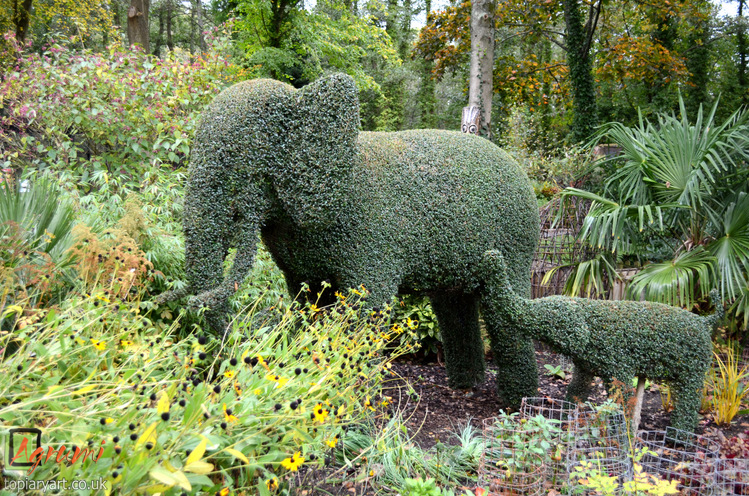


Star Jasmine (Trachelospermum Jasminoides)

If you're after something in a hurry this vigorous, evergreen twining plant is the ideal choice for bespoke topiary with fabulous results in a mere matter of weeks. It has oval leaves 5-8cm in length which often turn deep red in winter – lending another dimension to topiary figures. This plant also develops fragrant white flowers during the summer, an added bonus, 2-5cm in width that mellow to a cream colour with age.
Common Ivy (Hedera Helix)
 The genus Hedera is fast-growing, evergreen and there are many species within it. Agrumi use the small-leaved varieties, either plain or variegated depending on the commission.
The genus Hedera is fast-growing, evergreen and there are many species within it. Agrumi use the small-leaved varieties, either plain or variegated depending on the commission.

We can also use dried moss as an alternative to living topiary to create fuller looking topiary in an instant. Moss creates a healthy looking, soft, green topiary which requires very little maintenance. Eventually, after some time in the sun, your moss topiary will begin to lose colour and fade; not to worry, as the solution can be very simple! You may decide to remove and replace the old moss with a newer fresher product, or, simply fill in any areas which are loosing their colour. Alternatively the simpler solution is to spray/paint your topiary with a natural looking green paint.
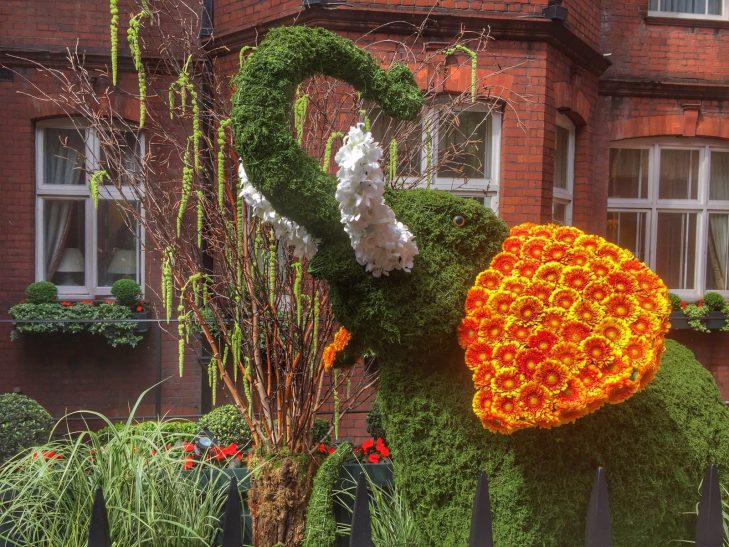
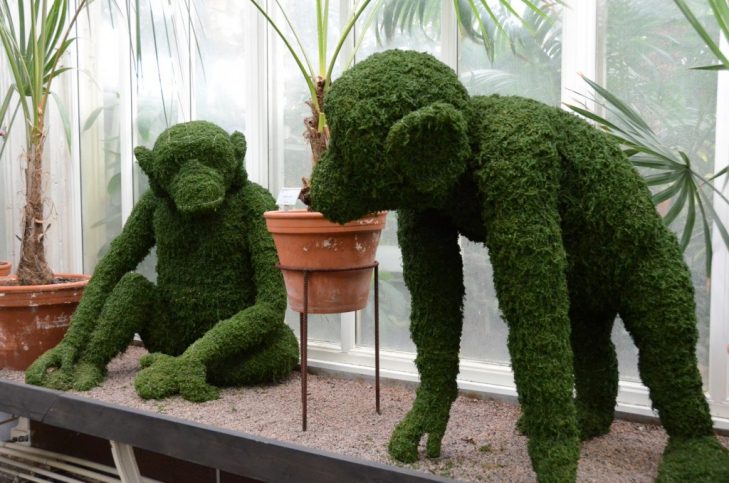

We also make topiary using a range of artificial plant/grass products; providing a long lasting, low maintenance alternative.
Artificial Boxwood matting can be very effective if you’re looking for a realistic plastic alternative to living plants. We use a variety with deep ‘foliage’ and tonal shades of green which replicate the real thing. It is also UV fade protected, for long-term outdoor use, sturdy, light to carry and weather-resistant; providing an instant ever lasting wow-factor that can be used time and again.
The same talented wire artists that create our living plant topiary can use this to make topiary that requires absolutely no on-going care. It’s the perfect choice for clients wanting to commission items that they can transport and use over and over again for event/exhibitions both indoors and out.
Price-wise bespoke topiary made from artificial Boxwood matting doesn't vary much from that made of living plants as it involves the same amount of work.
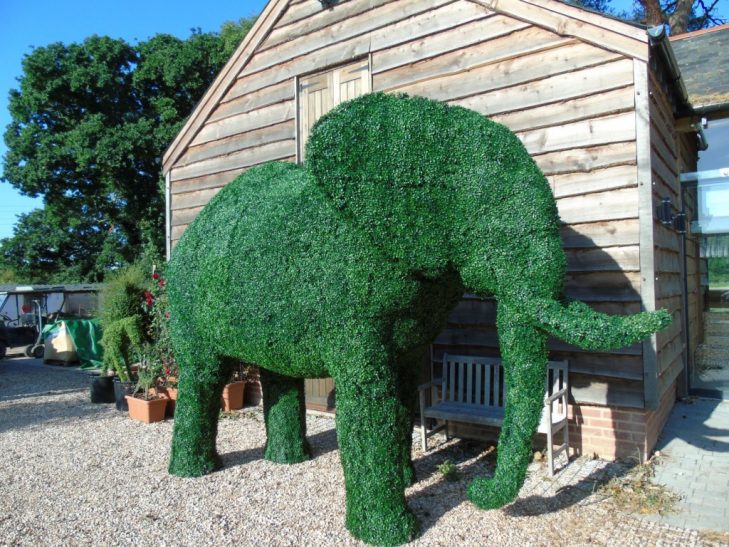


With artificial grass you can have great looking topiary instantly that doesn’t require any further care.
Artificial grass products have a natural look and feel, creating some stunning topiary designs, and are remarkably true to life
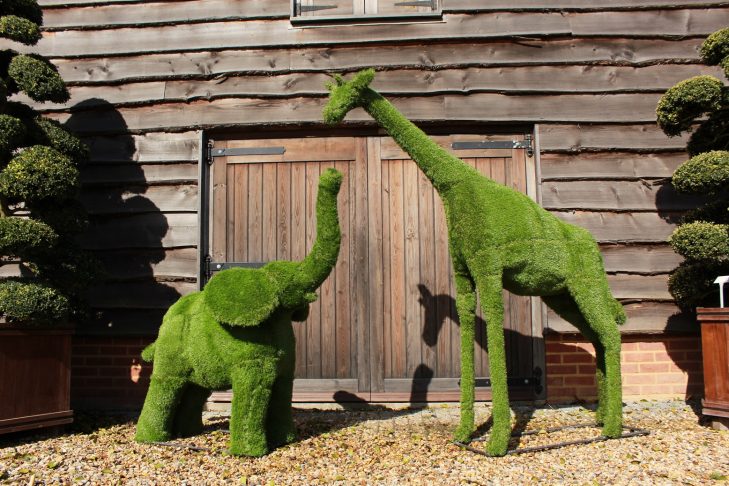

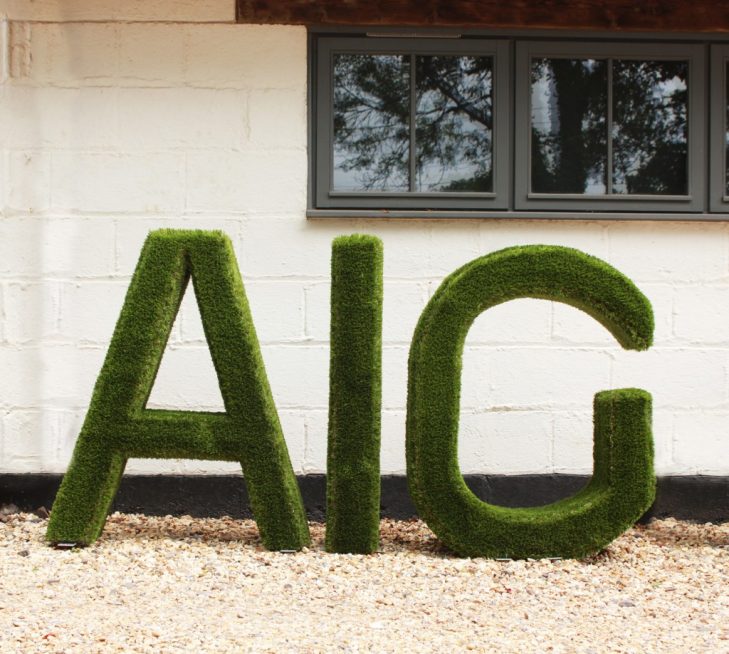
LED Lighting
Sometimes customers want something a bit different to brighten up their designs with; therefore, we offer a fantastic alternative sculpture covering in the form of LED lights. This combination of LED lights and our wire frame sculptures creates a beautiful effect that will joyfully light up the night!

Last Christmas Agrumi got into the festive spirit by covering one of our wire topiary deer frames in 1000 twinkly LED lights. The work took no more than a morning and the results were fantastic. ‘Rudolf’ was stationed outside our local pub in the New Forest, ‘The White Buck’, and helped raise funds for Greenfingers, the charity that creates magical gardens for children’s hospices.
Following on from the success of our topiary stiletto covered in Star Jasmine, made to mark a fashion event at St Christopher’s Place off London’s Oxford Street, we were later commissioned again to produce an updated replacement of the existing stiletto design, but this time covered in beautiful, twinkling, LED lights; ordered just in time for Christmas it was the perfect way to get shoppers into the festive spirit.
Agrumi can design, make and deliver commissions like this within a few days at remarkably low costs; whether its for an evening event, advertisement or to just add some sparkle to the garden at night we think these LED frames are guaranteed to brighten up your night.
Wire Frames

And, of course, we can supply all of our topiary figures in their most basic wire frame form; perfect if you're thinking of trying your hand at training your own topiary plant.
Whatever your desired shape, depending how complex/daring you feel, we can have topiary wire frames made at surprisingly affordable rates.
If you fancy getting started with something simple we can offer a circular cutting guide as to achieve precision pruning for the perfect topiary balls. Or express your creativity with something more intricate and have your art come to life.
Whatever you're after, any size and shape, we can provide the frame; what you do with it thereafter is up to you! We like a challenge, so if you have something else in mind such as garden frames, cages, hanging baskets, an archway or plant frames, just let us know via the contact us page or give us a call! Perhaps you’re after something not strictly for the garden; an ornamental piece or wire mannequin.
Take a look at our portfolio and case studies for more examples and inspiration!
We can supply all of these and more, any size or shape, to suit your needs.
Topiary art relies on a mutual relationship between you and your plant; the plants have been carefully sculpted to a frame and to maintain and even enhance the appearance of the sculpture some careful consideration and attention is required.
If you have purchased an artificial topiary product then, of course, no further maintenance is required; you can situate you topiary wherever is desired.
The majority of our living topiary products are made using Ligustrum delavayanum, commonly known as the Delavay Privet. There are a few basic principles to consider when caring for your new topiary plant:
Obviously you will wish to place your topiary where you can best appreciate it, but take a minute to make sure the plant is also getting the conditions that it requires.
Ideally, place in deep, fertile, well-drained soil in a sheltered partially shaded site; Ligustrum is a very adaptable plant, and thrives in most situations except permanently water-logged soil – hence it is well suited for growing in containers – or extreme cold.
During the summer or in hot/windy sites it is especially important to water your plant during the first two years to prevent them drying out. Watering should take place every day, preferably during the evening, and care should be taken to avoid wetting the leaves. If the pots are standing in trays make sure that they do not continually contain water as this may cause rotting of the roots. A mulch of ornamental gravel can help maintain water in the compost.
When the sculpture is located outside during the non-growing season and, given sufficient rain, very little watering is required. Keep an eye on the moisture level in the pot, ensure good drainage, and only water if there is a shortage.
Once the plants have become established after the first two years they will require far less watering.
If your topiary is left in the pot feeding your plant is essential for healthy growth; the nutrition available from the compost is quickly depleted, therefore a fertilizer will be necessary. The most convenient method is to use slow release fertilizer granules as they can be applied infrequently, depending on their life span; products such as Osmacote are readily available. You may wish to give plants in the ground the same slow release fertilizer; however it may not be necessary.
If your plant is suffering from a lack of nutrients, it will grow very slowly and the leaves will become coppery brown or develop cream/yellow tip. Ensure that proper growing conditions are restored and you can rejuvenate your plant in a few weeks.
 Ligustrum grows rapidly during the summer months and requires regular clipping to maintain the shape of the article. You can use garden shears
Ligustrum grows rapidly during the summer months and requires regular clipping to maintain the shape of the article. You can use garden shears
or a regular pair of scissors for this operation. If you’re looking to maintain the size and shape clipping every two to three weeks will be necessary during the growing season; once it stops in September it will no longer be necessary to trim until the next spring.
Increasing the size of the plant can be achieved by simply leaving an inch or two of new growth when trimming; while maintaining the thick bushy appearance and shape of the plant.
Topiary appreciate good air circulation; if you feel like the foliage becomes too thick it may be a good idea to thin out the growth, removing some of the longer branches, allowing more light and air into the body of the plant.
Ligustrum grows relatively well in containers, however, like any plant, has a smaller root ball when potted and requires more watering and feeding than the same when planted in the ground. It is advisable to re-pot the plants into a larger container every 2 years. This provides the plant with new compost and prevents the roots becoming pot bound. Pot bound plants make it difficult for the plant to access water and nutrients as the original compost will have been replaced with roots and the nutrients depleted.
If you cannot place your plant into a larger container, remove the plant and carefully remove some of the roots and soil from the root ball using a sharp knife and place back into the same pot. Mix the new compost with slow release fertilizer, it is preferable to use a loam based compost such as John Innes No 3; this will help rejuvenate your plant.
Keeping your topiary sculptures in good, healthy, condition will help them withstand any pests and diseases. However it is always a good idea to watch out for insects; such as leaf burrowing or scale forming insects. If you catch them early in the spring time you may be able to eradicate them with physical methods, removing the affected branches, or alternatively use chemical sprays to remove them. Likewise leaf spots, honey fungus and wilt can cause problems; be vigilant, ensure proper growing conditions are maintained and act early to prevent problems increasing.
Should the leaves of the sculpture become brown it’s likely that your plant isn’t receiving enough nutrients; a common problem with plants left in the pot if no new feed has been added and all the nutrients have been leached from the compost. Once the new fertilizer has been added the brown leaves should become green again within a few weeks.
Should the problem persist, it may be necessary to unwind the branches that are affected from the frame and to remove them with secateurs. This may expose the metal framework, however, leave the vegetation close to this area to grow and once they can cover the area exposed reattach them to the frame, twisting them in as you are able. The quick growing nature of Ligustrum means that the full shape and beauty are promptly restored.
We hope these instructions should help keep your sculpture in good condition and give you pleasure for many years to come.
The word ‘topiary’ is derived from the Latin word topiarius; meaning ‘landscape gardener’.
Topiary is the horticultural art of clipping and training shrubs or trees into ornamental shapes and sculptures. The resulting topiary shape can be as exotic and elaborate as desired; ranging from animal shapes and figures to a well trimmed hedge.
There are many different styles of topiary, each favoured by different regions of the world and at different times of history.
The most notable gardens, mazes and sculptures are discussed below.

This style of topiary became popular during the Italian Renaissance and influenced French gardens after the invasion of Italy by Charles VIII. Beautifully ornate, clipped hedges (often using Buxus Sempervirens, or Box) are laid out in symmetrical patterns, usually on a large scale. Gravel paths are often placed between the hedges with statues and plants in pots among them. As time went on the designs became more and more elaborate with colorful plants and flowers added for interest.

First established in England during the reign of Elizabeth I, these gardens again follow very formal designs with low hedges cut in criss-cross patterns literally resembling knots. Traditionally the hedges would be made from aromatic plants and culinary herbs. Today the hedges may be fashioned from Box (or similar) with gravel paths and aromatic plants and herbs in between. In this case they may be more accurately called Parterres.
In gardening terms, a maze is constructed from tall, clipped hedging and offers a branching puzzle to walk through with choices of path and direction. A labyrinth offers a single, non-branching path. The goal in each case is to reach the centre of the garden. Pleasure gardens with mazes and labyrinths evolved from the Parterre and Knot gardens of Renaissance Europe. The oldest surviving example in England was built for King William III in the late 17th century at Hampton Court Palace.
Topiary sculptures are a more modern development and most often consist of standard, geometric shapes like pyramids and spirals; however, the resurgence of topiary became a unique way to represent animals and figures, with its use in special displays such as at theme parks, festivals and promotional events across the globe. The shapes can be made by trimming a bushy shrub or tree down, or, by using a wire frame which can either be stuffed with moss or used as a pruning guide to grow plants around it.


Cnaeus Martius Calvinus, in the circle of Julius Caesar, is credited for introducing the very first topiary to Roman gardens, whilst Pliny the Younger, a magistrate of Ancient Rome, wrote letters describing the elaborate figures of animals, inscriptions, cyphers, and obelisks in clipped greens at his Tuscan villa. Miniature landscapes (topos) were also created within Roman houses and villas for the first time, forming an art called topiarius.
During the 1500s topiary was most commonly seen in the form of parterre and knot gardens belonging to wealthy families, as well as in simple cottage gardens on a smaller scale. Traditional topiary shapes such as balls, cubes, cones, spirals, and pyramids were also established at this time; these were used to form the vertical features within flat-patterned parterre gardens. During this early stage of topiary design, sculptural forms were provided by stone and lead sculptures.
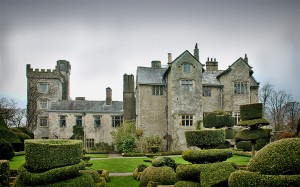
The fashion for more complicated topiary designs (in a Franco-Dutch style) spread to England around 1660 after having first been established in Holland. Levens Hall garden in Cumbria, England, is an example of a 17th century topiary garden, created by French gardener M. Beaumont in the 1690s. It is now recognised by the Guinness Book of Records as the oldest topiary garden in the world.
A satiric essay on “Verdant Sculpture” published by Alexander Pope in The Guardian in 1713 blew topiary out of fashion through mocking descriptions of unfinished sculptures and deformed figures heavily affected by the weather. In the 1720s and 1730s hedges, mazes, and topiary were cleared from aristocratic English gardens by prominent designers such as William Kent and Charles Bridgeman in favour of wilder, more natural-looking gardens. Topiary continued on a far smaller scale in cottage gardens, where traditional forms such as balls, cones, and the occasional peacock made impressive centre-pieces.
In the 1840s, the botanist and garden writer John Loudon expressed a sense of loss due to the removal of topiary from English gardens, and in the 1850s the grounds of Elvaston Castle in Derbyshire opened to public viewing, creating a sensation through its enclosed garden ‘rooms’ and gothic style. Within a few years architectural topiary was again back in fashion, followed by sculptural topiary in the 1870s. Popular gardening writer James Shirley Hibberd helped re-kindle England’s enthusiasm for topiary during the 1870s, by describing a plant sculpture as an expression of out ingenuity. English cottage-style gardens continued to be popular in the late 19th century, with the revival of topiary among roses and mixed herbaceous borders. Great Dixter house in Sussex is regarded as the epitome of English plantsmanship, sporting this stylised mix of topiary and ‘cottagey’ plantings.
In the mid-1900s topiarists began creating portable pieces - the new topiary - made of fast-growing, easily moulded plants trained over frames. The frame remains as a permanent trimming guide, and can be stuffed with moss then planted, or placed around pre-existing shrubbery. This style was first introduced to Disneyland in America, where cartoon characters were created in topiary-form to capture the imagination of visitors to the park.
The appreciation of portable topiary and mosaiculture (multiple types and styles of planting to create a mosaic-like, living sculpture) has continued to the present day, with impressive examples such as the 2008 Summer Olympics in China, and entries of modern topiary art to the Philadelphia Flower Show each year. Interest in the revival of historic gardens has led to traditional topiary being re-planted and maintained for the public to enjoy; an example of this is the parterre garden at the Château de Villandry, France.